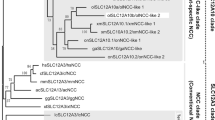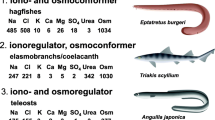Abstract
Freshwater teleosts are challenged by diffusive ion loss across permeable epithelia including gills and skin. Although the mechanisms regulating ion loss are poorly understood, a significant component is thought to involve paracellular efflux through pathways formed via tight junction proteins. The mammalian orthologue (claudin-4) of zebrafish (Danio rerio) tight junction protein, claudin-b, has been proposed to form a cation-selective barrier regulating the paracellular loss of Na+. The present study investigated the cellular localization and regulation of claudin-b, as well as its potential contribution to Na+ homeostasis in adult zebrafish acclimated to ion-poor water. Using a green fluorescent protein-expressing line of transgenic zebrafish, we found that claudin-b was expressed along the lamellar epithelium as well as on the filament in the inter-lamellar regions. Co-localization of claudin-b and Na+/K+-ATPase was observed, suggesting its interaction with mitochondrion-rich cells. Claudin-b also appeared to be associated with other cell types, including the pavement cells. In the kidney, claudin-b was expressed predominantly in the collecting tubules. In addition, exposure to ion-poor water caused a significant increase in claudin-b abundance as well as a decrease in Na+ efflux, suggesting a possible role for claudin-b in regulating paracellular Na+ loss. Interestingly, the whole-body uptake of a paracellular permeability marker, polyethylene glycol-400, increased significantly after prolonged exposure to ion-poor water, indicating that an increase in epithelial permeability is not necessarily coupled with an increase in passive Na+ loss. Overall, our study suggests that in ion-poor conditions, claudin-b may contribute to a selective reduction in passive Na+ loss in zebrafish.







Similar content being viewed by others
References
Allen PJ, Weihrauch D, Grandmaison V, Dasiewicz P, Peake SJ, Anderson WG (2011) The influence of environmental calcium concentrations on calcium flux, compensatory drinking and epithelial calcium channel expression in a freshwater cartilaginous fish. J Exp Biol 214:996–1006
Anderson JM, Van Itallie CM (2009) Physiology and function of the tight junction. Cold Spring Harb Perspect Biol 1(1):a002584
Bagherie-Lachidan M, Wright S, Kelly S (2009) Claudin-8 and -27 tight junction proteins in puffer fish Tetraodon nigroviridis acclimated to freshwater and seawater. J Comp Physiol B 179:419–431
Balda MS, Whitney JA, Flores C, González S, Cereijido M, Matter K (1996) Functional dissociation of paracellular permeability and transepithelial electrical resistance and disruption of the apical-basolateral intramembrane diffusion barrier by expression of a mutant tight junction membrane protein. J Cell Biol 134:1031–1049
Boisen AMZ, Amstrup J, Novak I, Grosell M (2003) Sodium and chloride transport in soft water and hard water acclimated zebrafish (Danio rerio). Biochim Biophys Acta 1618:207–218
Brix KV, Grosell M (2012) Comparative characterization of Na+ transport in Cyprinodon variegatus variegatus and Cyprinodon variegatus hubbsi: a model species complex for studying teleost invasion of freshwater. J Exp Biol 215:1199–1209
Chasiotis H, Kelly SP (2008) Occludin immunolocalization and protein expression in goldfish. J Exp Biol 211:1524–1534
Chasiotis H, Kelly SP (2011) Effect of cortisol on permeability and tight junction protein transcript abundance in primary cultured gill epithelia from stenohaline goldfish and euryhaline trout. Gen Comp Endocr 172:494–504
Chasiotis H, Kolosov D, Kelly SP (2012) Permeability properties of the teleost gill epithelium under ion-poor conditions. Am J Physiol Reg I 302:727–739
Clelland ES, Kelly SP (2010) Tight junction proteins in zebrafish ovarian follicles: stage specific mRNA abundance and response to 17β-estradiol, human chorionic gonadotropin, and maturation inducing hormone. Gen Comp Endocr 168:388–400
Cuthbert AW, Maetz J (1972) The effects of calcium and magnesium on sodium fluxes through gills of Carassius auratus, L. J Physiol 221:633–643
Duffy NM, Bui P, Bagherie-Lachidan M, Kelly SP (2011) Epithelial remodeling and claudin mRNA abundance in the gill and kidney of puffer fish (Tetraodon biocellatus) acclimated to altered environmental ion levels. J Comp Physiol B 181:219–238
Engelund MB, Yu ASL, Li J, Madsen SS, Færgeman NJ, Tipsmark CK (2012) Functional characterization and localization of a gill-specific claudin isoform in Atlantic salmon. Am J Physiol Reg I 302:R300–R311
Evans DH, Piermarini PM, Choe KP (2005) The multifunctional fish gill: dominant site of gas exchange, osmoregulation, acid-base regulation, and excretion of nitrogenous waste. Physiol Rev 85:97–177
Furuse M, Tsukita S (2006) Claudins in occluding junctions of humans and flies. Trends Cell Biol 16:181–188
Furuse M, Furuse K, Sasaki H, Tsukita S (2001) Conversion of zonulae occludentes from tight to leaky strand type by introducing claudin-2 into Madin–Darby canine kidney I cells. J Cell Biol 153:263–272
Haas P, Gilmour D (2006) Chemokine signaling mediates self-organizing tissue migration in the zebrafish lateral line. Dev Cell 10:673–680
Hansen HJM, Grosell MH, Rosenkilde P (1999) Gill lipid metabolism and unidirectional Na+ flux in the European eel (Anguilla anguilla) after transfer to dilute media: the formation of wax alcohols as a primary response. Aquaculture 177:277–283
Horng J-L, Lin L-Y, Huang C-J, Katoh F, Kaneko T, Hwang P–P (2007) Knockdown of V-ATPase subunit A (atp6v1a) impairs acid secretion and ion balance in zebrafish (Danio rerio). Am J Physiol -Reg I 292:2068–2076
Hwang P–P, Lee T-H, Lin L-Y (2011) Ion regulation in fish gills: recent progress in the cellular and molecular mechanisms. Am J Physiol -Reg I 301:28–47
Jönsson ME, Carlsson C, Smith RW, Pärt P (2006) Effects of copper on CYP1A activity and epithelial barrier properties in the rainbow trout gill. Aquat Toxicol 79:78–86
Kiuchi-Saishin Y, Gotoh S, Furuse M, Takasuga A, Tano Y, Tsukita S (2002) Differential expression patterns of claudins, tight junction membrane proteins, in mouse nephron segments. J Am Soc Nephrol 13:875–886
Kollmar R, Nakamura SK, Kappler JA, Hudspeth AJ (2001) Expression and phylogeny of claudins in vertebrate primordia. P Natl Acad Sci 98:10196–10201
Kumai Y, Bahubeshi A, Steele S, Perry SF (2011) Strategies for maintaining Na+ balance in zebrafish (Danio rerio) during prolonged exposure to acidic water. Comp Biochem Physiol -A 160:52–62
Martinez-Palomo A, Meza I, Beaty G, Cereijido M (1980) Experimental modulation of occluding junctions in a cultured transporting epithelium. J Cell Biol 87:736–745
McCarthy KM, Francis SA, McCormack JM, Lai J, Rogers RA, Skare IB, Lynch RD, Schneeberger EE (2000) Inducible expression of claudin-1-myc but not occludin-VSV-G results in aberrant tight junction strand formation in MDCK cells. J Cell Sci 113:3387–3398
McDonald DG, Rogano MS (1986) Ion regulation by the rainbow trout, Salmo gairdneri, in ion-poor water. Physiol Zool 59:318–331
Morita K, Sasaki H, Furuse M, Tsukita S (1999) Endothelial claudin: Claudin-5/TMVCF constitutes tight junction strands in endothelial cells. J Cell Biol 147:185–194
Nakada T, Hoshijima K, Esaki M, Nagayoshi S, Kawakami K, Hirose S (2007) Localization of ammonia transporter Rhcg1 in mitochondrion-rich cells of yolk sac, gill, and kidney of zebrafish and its ionic strength-dependent expression. Am J Physiol Reg I 293:R1743–R1753
Perry SF, Laurent P (1989) Adaptational responses of rainbow trout to lowered external NaCl concentration: contribution of the branchial chloride cell. J Exp Biol 147:147–168
Pfaffl MW (2001) A new mathematical model for relative quantification in real-time RT-PCR. Nucleic Acids Res 29(9):e45
Rahner C, Mitic LL, Anderson JM (2001) Heterogeneity in expression and subcellular localization of claudins 2, 3, 4, and 5 in the rat liver, pancreas, and gut. Gastroenterology 120:411–422
Rasband WS (2006) ImageJ. US National Institutes of Health, Bethesda
Shen L, Weber CR, Raleigh DR, Yu D, Turner JR (2011) Tight junction pore and leak pathways: a dynamic duo. Annu Rev Physiol 73:283–309
Tipsmark CK, Kiilerich P, Nilsen TO, Ebbesson LOE, Stefansson SO, Madsen SS (2008) Branchial expression patterns of claudin isoforms in Atlantic salmon during seawater acclimation and smoltification. Am J Physiol Reg I 294:R1563–R1574
Turksen K, Troy TC (2004) Barriers built on claudins. J Cell Sci 117:2435–2447
Van Itallie CM, Anderson JM (2006) Claudins and epithelial paracellular transport. Annu Rev Physiol 68:403–429
Van Itallie C, Rahner C, Anderson JM (2001) Regulated expression of claudin-4 decreases paracellular conductance through a selective decrease in sodium permeability. J Clin Invest 107:1319–1327
Van Itallie CM, Holmes J, Bridges A, Gookin JL, Coccaro MR, Proctor W, Colegio OR, Anderson JM (2008) The density of small tight junction pores varies among cell types and is increased by expression of claudin-2. J Cell Sci 121:298–305
Wingert RA, Davidson AJ (2008) The zebrafish pronephros: a model to study nephron segmentation. Kidney Int 73:1120–1127
Wood CM, Grosell M (2012) Independence of net water flux from paracellular permeability in the intestine of Fundulus heteroclitus, a euryhaline teleost. J Exp Biol 215:508–517
Wood CM, Iftikar FI, Scott GR, De Boeck G, Sloman KA, Matey V, Domingos FXV, Duarte RM, Almeida-Val VMF, Val AL (2009) Regulation of gill transcellular permeability and renal function during acute hypoxia in the Amazonian Oscar (Astronotus ocellatus): new angles to the osmorespiratory compromise. J Exp Biol 212:1949–1964
Acknowledgments
We thank Dr. T. Piotrowski (University of Utah, UT, USA) for generously donating claudin-b GFP transgenic zebrafish. We also thank J. Bradshaw and V. Saxena for their technical assistance. This study was funded by Natural Sciences and Engineering Research Council of Canada (NSERC) Discovery and Research Tools and Innovation grants to SFP.
Author information
Authors and Affiliations
Corresponding author
Additional information
Communicated by G. Heldmaier.
Rights and permissions
About this article
Cite this article
Kwong, R.W.M., Kumai, Y. & Perry, S.F. Evidence for a role of tight junctions in regulating sodium permeability in zebrafish (Danio rerio) acclimated to ion-poor water. J Comp Physiol B 183, 203–213 (2013). https://doi.org/10.1007/s00360-012-0700-9
Received:
Revised:
Accepted:
Published:
Issue Date:
DOI: https://doi.org/10.1007/s00360-012-0700-9




